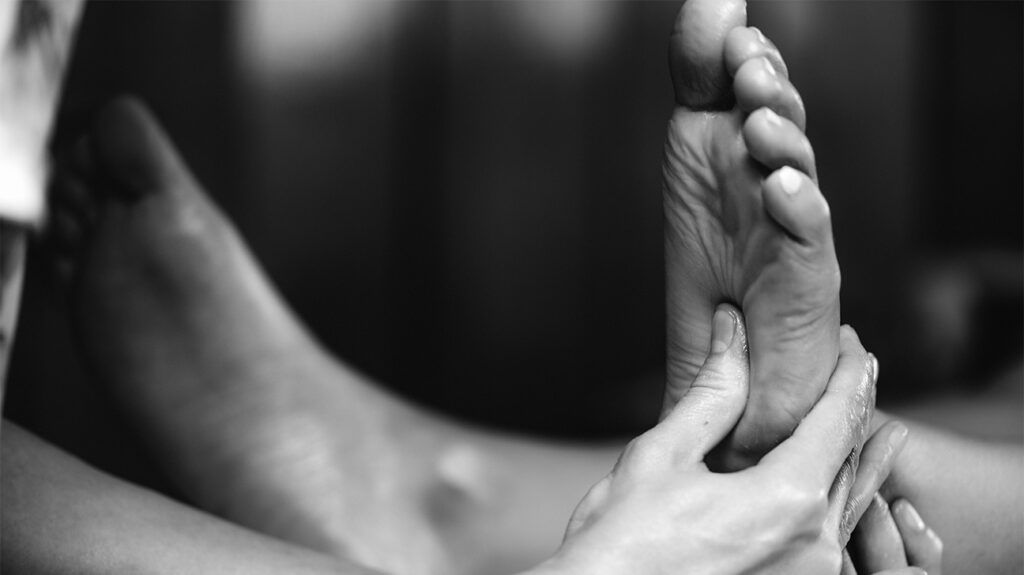People living with psoriasis may experience chronic pain. Some individuals claim reflexology may help ease this pain, but not much clinical evidence supports this.
Reflexology uses massage to apply pressure to certain points in the feet, hands, and ears. Some people believe these points connect to other areas of the body and that applying pressure to them can help a person with various issues, such as pain.
Pain is a common symptom of psoriasis, which means, in theory, reflexology may be helpful for psoriasis pain. This article explores the use of reflexology and its potential effects on psoriasis-related pain.

Reflexology is a practice that involves applying pressure to specific points in the hands, feet, and ears. It may help with a variety of health concerns, including:
stress management anxiety and depression - pain management
Reflexology may help a person living with psoriasis with pain management and potential co-occurring conditions, such as depression. However, evidence for its effects on pain management is lacking.
In fact,
Is reflexology the same as acupressure and massage?
Reflexology is similar to acupressure insofar as they both involve manipulating points on the body. However, the areas of the body they focus on are different. Reflexology focuses on the hands, feet, and ears, while acupressure can involve around
Reflex and massage share some similarities, as they both involve manipulating parts of the body. However, massage focuses on the soft tissues of the body to help relax muscles. Unlike massage, a person is typically fully clothed during a reflexology session.
Proponents of reflexology state that by manipulating and applying pressure to certain points in the hands, feet, and ears, a person can provide therapeutic benefits to the corresponding areas of the body.
Experts at the University of Minnesota offer several theories on how it works:
- It reduces stress, which then reduces pain: This theory states that a person’s stress level can influence how they experience pain, and by reducing stress, a person will find some pain relief.
- It relaxes the central nervous system: This theory states that manipulating the hands, feet, and ears can send a signal through the nerves to the central nervous system, which can then reduce a person’s pain.
- Reflexology keeps vital energy flowing: This theory suggests that reflexology helps to keep positive energy flowing throughout the body by reducing stress, which can block the energy from flowing.
- Zone theory: This theory divides the body into 10 different vertical zones. The points on the hands, feet, ears, and other parts of the body correspond to the different zones. By manipulating them, a person can affect different areas of the body.
Anyone interested in receiving the therapy can look for an experienced therapist who can teach them about what they are doing, particularly if they want to try it themselves at home.
At a session, a therapist will massage or manipulate different points on the ears, hands, or feet to help alleviate a person’s symptoms.
Reflexology pressure points
Reflexology focuses on pressure points on the:
- feet
- hands
- ears
Each area corresponds to a specific organ or part of the body. If a person is experiencing pain in a specific area, the reflexologist can manipulate the corresponding pressure point.
Pressure points also correspond to a specific side of the body. For example, if a person is experiencing pain on the left side of their body, the reflexologist may focus on pressure points on the left foot.
Learn more about pressure points and foot reflexology.
Proponents of reflexology claim that by manipulating or putting pressure on certain points in the hands, feet, or ears, a person can find relief from symptoms such as pain. While these claims may hold true for some, scientific evidence is lacking.
For example, a
Other potential evidence for its use comes from looking at acupuncture, a related therapy, and psoriasis. However, in a
The primary benefit of reflexology to a person living with psoriasis is pain relief. Limited evidence
Another possible area where reflexology may help is with co-occurring conditions, such as anxiety and depression. In a small
Some evidence suggests that reflexology
Here are some common questions about acupuncture and psoriasis.
Can acupressure help psoriasis?
A 2016 overview of literature suggests that acupuncture can be an effective treatment for psoriasis with minimal side effects. However, a person should contact their doctor before beginning complementary therapy such as acupuncture. It may not be suitable for everybody.
Learn more about acupuncture for psoriasis.
What are trigger points for psoriasis?
Trigger points for psoriasis may refer to the reflexology trigger points that some people believe can help alleviate pain associated with psoriasis. These include trigger points on the hands, feet, and ears.
Reflexology may provide some benefits to people living with psoriasis, but the clinical evidence is generally lacking.
Proponents suggest it can help manipulate stress levels, which can then help with pain. It may also help with other conditions, such as depression and anxiety, that can appear alongside psoriasis.
